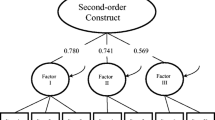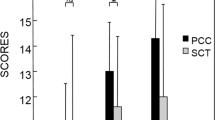Abstract
Script concordance test (SCT) is a case based assessment format of clinical reasoning in which questions are nested into several cases. Recent results using Q4 format suggest that nested questions contribute more to reliability of measure than cases. The present study aims at documenting variance components associated with SCT cases and nested questions and to determine what are the optimal number and combinations of cases and nested questions. Data from SCT in three different fields are presented. G study and D study methodology are used to estimate variance component and to determine optimal number and combinations of cases and questions. Questions nested into cases contributed a large amount of score variance (more than 70%). D studies with varying samples show that, depending on the reliability of the test, an optimal number of 2–4 questions nested into 15–25 cases represents the best combination. Nested questions contribute to a significant portion of score variance, with the implication that formulation of up to 5 questions per case is an efficient way to optimize the reliability of SCT scores.



Similar content being viewed by others
References
Boegels, S. M., van Mourik, T., & Van Der Vleuten, C. (1995). Authentic assessment of interviewing and counseling skills: Effect of testing time per station on generalizability and validity. Teaching and Learning in Medicine, 7(3), 155–162.
Brennan, R. (2001). Generalizability theory. New York: Springer.
Carrière, B. (2005). Development of script concordance test in pediatric emergency medicine. Master degree dissertation MHPE. University of Illinois, Chicago.
Charlin, B., Tardif, J., & Boshuizen, H. P. (2000). Scripts and medical diagnostic knowledge: Theory and applications for clinical reasoning instruction and research. Academic Medicine, 75(2), 182–190. doi:10.1097/00001888-200002000-00020.
Charlin, B., Gagnon, R., Sauvé, E., & Coletti, M. (2007). Composition of the panel of reference for concordance tests: Do teaching functions have an impact on examinees’ ranks and absolute scores? Medical Teacher, 29, 43–53. doi:10.1080/01421590601032427.
Deschênes, M. F. (2006). Développement d’un TCS en sciences infirmières. Dissertation, Faculty of Nursing, University of Montréal.
Lambert, C. (2006). Développement d’un TCS en radio-oncologie. Dissertation, Faculty of medicine, University of Montréal.
Norman, G., Bordage, G., Page, G., & Keane, D. (2006). How specific is case specificity? Medical education, 40(7), 618–623. doi:10.1111/j.1365-2929.2006.02511.x.
Author information
Authors and Affiliations
Corresponding author
Rights and permissions
About this article
Cite this article
Gagnon, R., Charlin, B., Lambert, C. et al. Script concordance testing: more cases or more questions?. Adv in Health Sci Educ 14, 367–375 (2009). https://doi.org/10.1007/s10459-008-9120-8
Received:
Accepted:
Published:
Issue Date:
DOI: https://doi.org/10.1007/s10459-008-9120-8




